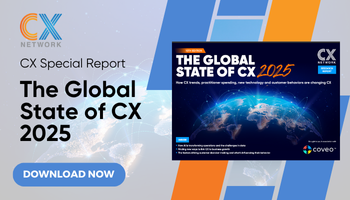How to be a CX leader: Lessons from FedEx
Scott Wilson, customer experience principal at FedEx, discusses the evolution of CX and where the role is heading in the future
Add bookmark
Scott Wilson, CX principal at FedEx, shares his insights on the evolution of CX and how CX leaders can stay ahead of the game including:
- What is your current role at FedEx?
- How do you prioritize what you do next?
- How has the role of the CX leader evolved in the last five years?
- What other roles do you believe will be incorporated into CX?
- How can CX practitioners communicate effectively?
- How can CX leaders ensure they are not the victims of silos?
- How can they communicate through the silos regardless?
- What are the core organizational values to be aware of when starting in a CX role?
- What can we look forward to at your upcoming presentation at CX Network LIVE: North America?

Don't miss any news, updates or insider tips from CX Network by getting them delivered to your inbox. Sign up to our newsletter and join our community of experts.
CX Network: What is your current role at FedEx?
Scott Wilson: I oversee the corporate customer experience steering committee for FedEx. The committee looks at enterprise-wide customer experience initiatives. Things that rise to the level of needing an enterprise level view to provide governance and oversight for initiatives to make sure we are breaking down silos and solving resource constraints at the corporate level.
That is the primary function – the other part is to set the corporate level strategy for the fiscal year to review the customer landscape. We determine what initiatives we need to focus on in the coming years and prioritize them and resource them accordingly.
CX Network: How do you prioritize what you do next?
Scott Wilson: We have a robust market research department looking at existing customer loyalty and satisfaction and we also have a substantial amount of blind research where we test what the expectations are in the market. We also include any new industry best practices and an in-depth review of the competitive landscape in our assessment.
Read: What Is customer journey mapping? The Complete CX Network Guide
We combine all that information to identify opportunities to improve or differentiate in the marketplace. We do not have a specific metric to determine the path we take as there is still a lot of "marketing art" to consider.
CX Network: How has the role of the CX leader evolved in the last five years?
Scott Wilson: The industry has moved from a touch-point focus to consideration of the entire customer journey. Even five years ago, there was a great deal of confusion between customer service and customer experience. While problem-solving has always been a priority, we began to accept the value of the customer journey from initial brand awareness all the way through to recommendations and reviews on products and services.
That has progressed even further today to understand the many parts of the organization that has to work together throughout the entire customer journey. At the moment, the biggest challenge for CX leaders is a need to wear so many hats.
On the one hand, you must be innovative, have traditional management skills, determine ROI required from leadership, and possess marketing savvy, data analysis skills, research, etc. These skills are necessary for the customer experience professional in today’s environment. Ultimately, in today's environment, one must be a mix of a data scientist, marketing leader, and an innovator all rolled into one.
CX Network: What other roles do you believe will be incorporated into CX?
Scott Wilson: A CX leader must know the current technology. Being tech-savvy is now a priority with new technologies like AI, chatbots, and self-service channels being expected by customers as basic CX elements.
We’re not just talking about AI in chatbots and virtual help online, we’re also talking about visual virtual assistants able to interpret emotions from facial expressions from a phone or laptop camera and respond accordingly. The complexity of the technology being leveraged in CX today is moving quickly and to be able have a great grasp of technology in the space today is definitely key.
Read: How to be a CX leader: Lessons from LinkedIn
On the other hand, there are many technologies that are great on paper but are unhelpful in reality. We need to know which things will help our customers. Even today, we focus a lot of work on trying to make automated help more human, but we sometimes forget that the main priority is to make automated help more helpful and we can often lose sight of that. Technology expertise will definitely be a priority for CX leaders in the next five years.
CX Network: How can CX practitioners communicate effectively?
Scott Wilson: At FedEx, we understand the value of CX and what it means to make it easier for customers to do business. Our leadership needs to see this in numbers so that cost can justify the returns. While we are not there at this stage in terms of broadly accepting metrics to see what is clear what ROI is on a CX project, we still need to keep working in this area.
We find that in our organization, a CSAT score can be a proxy for customer satisfaction.
But, whatever metrics matter to your leadership, is what you should build your customer experience program around and make sure you are building your program around the ability to use these the measure these. Many organizations depend on metric to metric progress.
We don’t yet have a solid set of metrics in the CX space – we need to work in the framework where we can have definable numerical progress as we move towards our CX goals.
CX Network: How can CX leaders ensure they are not the victims of silos?
Scott Wilson: The governance and oversight provided by the committee can help ensure that silos do not develop around the touch points. When you are looking end to end the risk is that different pieces of the organization will only focus on the touch points that matters to them and you end up with a disconnected experience.
Read: What is NPS? The Complete CX Network Guide
A steering committee can help ensure that we are thinking about the customer along a continuous journey. We have to know where the customer is coming from and where they are going next. You need to work with your organization for those hand-off's, and that is the best way to ensure silos don’t develop.
CX Network: How can they communicate through the silos regardless?
Scott Wilson: Colleagues in their own segments want to know how they are doing and organize their work around improving what is immediate to them. For example, on a problem resolution touch point, a customer will call in and the director of that touch point to satisfy the customer - utilizing metrics like the length of the call and first call resolution.
Because of this, you can get blinders as there is no consideration for how the customer got to that touch point. We get so laser focused on solving the immediate problem and do not learn how to prevent the problem from occurring for the next customer.
The data and insight we capture from that while solving that problem lives in the system and does not move to another touch point – such as a sales rep who can help to prevent the issue from occurring.
When we have governance and oversight at the enterprise level, we can have that conversation while the projects are being developed. We may set 4 components to a touch point to ask them to figure out how to close the loop and ensure the information gets back to operations, so it doesn't happen again. The milestones are not necessarily metrics, but they are requirements that will ensure touch points are connected.
CX Network: What are the core organizational values to be aware of when starting in a CX role?
Scott Wilson: Every organization should have an unwavering commitment to the customer. We’re in a market where the service we provide has been around for a long time, so it is very mature. We succeed through differentiation and operational efficiency and these two can sometimes work against each other.
Listen:
As a result, when you walk into an organization, the level of commitment to the customer and the level of commitment to the business must be understood. This will provide insight into what projects you should take on. In a market that is mature you need to make sure you are choosing projects that set you apart from the competition while also maintaining, or hopefully, increasing efficiency. If you’re in an emerging market you may be more focused on “wowing” the customer at any cost to gain market share and establish your brand. It is really about understanding your marketplace and those dynamics between customer experience and business strategy.
CX Network: What can we look forward to at your upcoming presentation at CX Network LIVE: North America?
Scott Wilson: Breaking down silos is where I spend a lot of my time. I also talk a lot about my experience with the benefits of a steering committee. There is a great deal of interest from CX leaders on how to get executive buy-in throughout the organization to ensure collaboration between different departments. Ultimately, ensuring that we’re all working to the same end and focusing on the full journey.
Special Report: The Global State of CX

Tenth annual flagship report. AI has transformed CX, raising expectations with investment in AI for CX automation, machine learning, and conversational AI now a top priority. Download the Global State of CX to learn how the industry is preparing for the new AI first future.
Download Now
